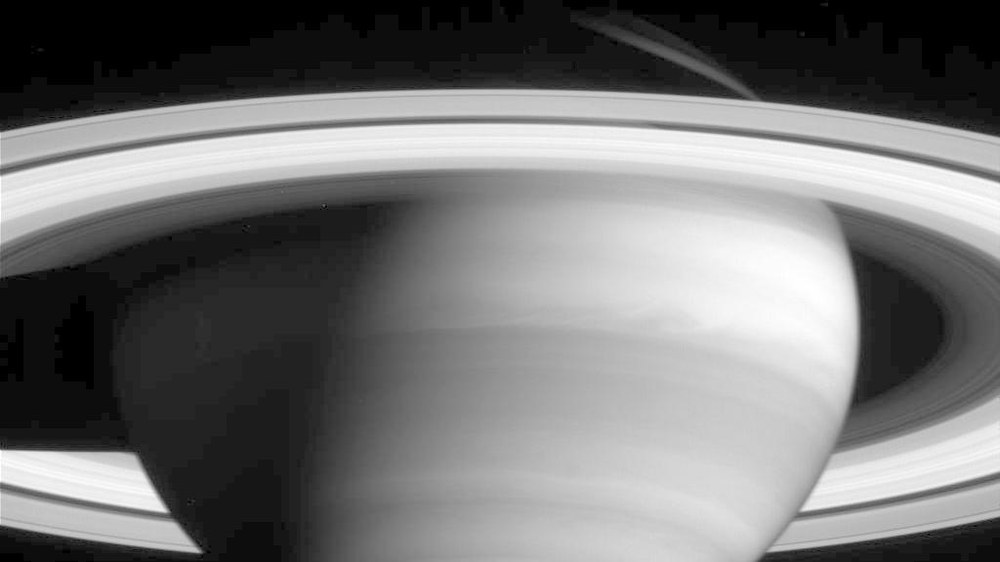Saturn – The ringed planet
Saturn is one of the planets that can be seen from Earth with the naked eye. It is the sixth planet from the Sun, between Jupiter and Uranus. With an equatorial diameter of 120,000 kilometres, it is the second largest planet in our Solar System after Jupiter. The temperature of Saturn's atmosphere is a chilly -180 degrees Celsius. Saturn is also the 'windiest' planet, with atmospheric winds of up to 1600 kilometres per hour, much stronger than in the atmosphere of Jupiter. Saturn is composed mainly of hydrogen and helium.
The ringed planet is nine times further away from the Sun than the Earth. From Saturn, the Sun would appear just one tenth of the size it does on Earth and the intensity of the Sun's radiation is just one percent of that which reaches us on Earth. Any given spot on Earth receives 90 times more sunlight than a comparable spot on Saturn. The further a planet is from the Sun, the more time it takes to complete an orbit. A year on Saturn is the same as 29.46 Earth years.
The planet's most striking feature is its unique ring system. This is composed of thousands of individual rings which themselves are made up of small chunks of ice, from the size of a speck of dust to the size of a family house. The particles that orbit around Saturn's equator are so densely packed together that from a distance, they appear as an opaque plane whose outermost ring has a diameter of 280,000 kilometres. Yet this 'plane' is less than one kilometre thick. Saturn's ring system is divided into seven main rings. These were named in the order in which they were discovered, not in the order of their distance from the planet. Starting from Saturn and working outwards, they are known as the D, C, B, A, F, G and E rings.
The moons of Saturn
Until 24 March 1655, only two planets were known to possess moons: Earth and Jupiter. Then Christiaan Huygens added the ringed planet Saturn to the list by discovering its largest moon, Titan. Since then, 47 moons have been discovered orbiting Saturn, 15 of which have been discovered since the launch of the Cassini-Huygens mission. Titan is Saturn's largest moon (with a diameter of 5150 kilometres) and the second largest moon in our Solar System. It is bigger than the planet Mercury and is the only moon in our Solar System to have a dense atmosphere.
Saturn's other moons are smaller, with diameters of less than 1600 kilometres. Some of these, such as Pan, Atlas, Prometheus and Pandora, are known as 'shepherd moons', which means that they keep the orbiting particles in one particular ring. The surface of the second largest moon, Rhea, is peppered with impact craters. The moon Enceladus is one of the brightest in the Solar System. Its surface is covered in water ice and reflects sunlight rather like freshly fallen snow. This is why the temperature on Enceladus is around -201 degrees Celsius. The landscape of Mimas is dominated by a gigantic impact crater, plunging more than 20 kilometres from the tip of the central peak to the crater floor. On the surface of Tethys, scientists have discovered a huge system of trenches that presumably covers the entire moon.
But the strangest of Saturn's moons has to be Iapetus. This moon has a bright side and a dark side, a unique feature in our Solar System, the cause of which has yet to be explained. The moons Janus and Epimetheus swap orbits in a regular four-year cycle. Because of Hyperion's chaotic rotation it is impossible to calculate when any particular area of its surface will be facing the Sun, even several months in advance. Both Hyperion and Phoebe, with its distant orbit, are the only moons of Saturn which are not locked into synchronous rotation, in other words they do not always keep the same side facing towards Saturn. This rotation, combined with its dark colour, have prompted scientists to theorise that Phoebe could be a body captured from the outer Solar System.

